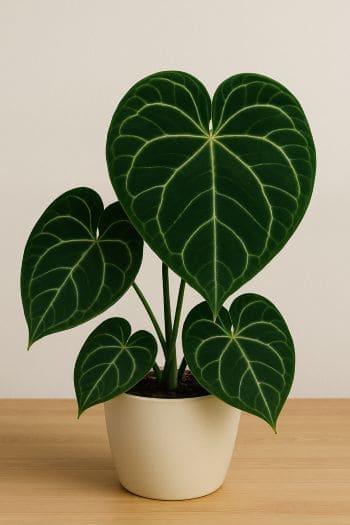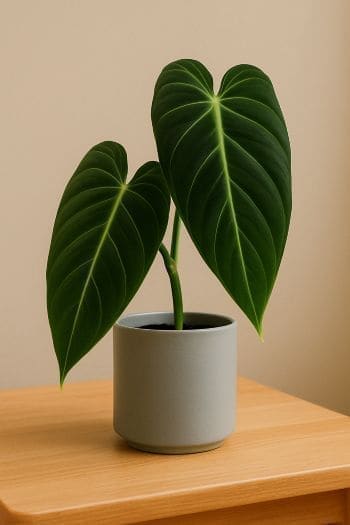Anthurium magnificum Care & Growing Guide
Overview
Anthurium magnificum is a striking tropical plant prized for its large, velvety leaves and prominent white venation. Native to the rainforests of Colombia, this species thrives in warm, humid environments and makes a statement as a houseplant when given the right care. It belongs to the Araceae family and is closely related to other ornamental Anthuriums, though it can be distinguished by its unique quadrangular petioles. In its natural habitat, it grows as a terrestrial or epiphytic plant in the understory, benefiting from filtered light and consistent moisture.
Identification & Growth Habit
Anthurium magnificum is best known for its broad, heart-shaped leaves that can reach over 30 cm in width under optimal conditions. The foliage has a velvety texture with pronounced, pale veins that contrast beautifully against the deep green leaf surface. A key identifying feature is its quadrangular petioles—a cross-section reveals a four-angled shape, which helps differentiate it from similar species like Anthurium crystallinum.
Growth is typically upright to slightly spreading, with leaves emerging from a central stem. While not a true climber like some aroids, it can be trained vertically on a moss pole or trellis to support larger leaves and encourage healthy development.
Light & Placement
Place your Anthurium magnificum in bright, indirect light. Direct sun can scorch its delicate leaves, leaving unsightly brown patches, while insufficient light may lead to slower growth and less vibrant foliage. An east-facing window with filtered morning sun or a few feet back from a south- or west-facing window is ideal. If natural light is limited, supplement with a full-spectrum grow light positioned to mimic gentle daylight.
Watering & Humidity
Water when the top 1–2 inches (2.5–5 cm) of soil have dried out. Overwatering is a common cause of root rot in Anthuriums, so ensure excess water drains freely from the pot. Use filtered or rainwater to avoid mineral build-up, which can damage the roots and leaf edges.
Humidity is critical—aim for 60–80%. In drier climates or during winter heating, increase humidity with a humidifier, group plants together, or use a pebble tray with water beneath the pot (without letting the pot sit directly in water). Regular misting can help, though it is less effective than ambient humidity control.
Soil & Repotting
A well-draining, chunky mix is essential to mimic the plant’s natural forest floor conditions. A recommended blend includes:
- Orchid bark for aeration
- Perlite for drainage
- Peat moss or coco coir for moisture retention
Repot every 1–2 years in spring when the plant shows signs of being root-bound or the potting mix has broken down. Choose a pot with drainage holes to prevent waterlogging.
Fertilizing
During the active growing season (spring and summer), feed with a balanced, diluted liquid fertilizer every 4–6 weeks. Reduce or stop fertilizing in autumn and winter when growth naturally slows. Overfertilization can cause leaf burn, so always follow dilution guidelines.
Pruning & Training
Prune away yellowing or damaged leaves to maintain appearance and plant health. While Anthurium magnificum is not a vigorous climber, it can be trained to grow upright using a moss pole or trellis. This support can help leaves grow larger and more symmetrical. Secure stems gently with soft ties to avoid damage.
Propagation
Division
- Remove the plant from its pot and gently shake off excess soil.
- Identify natural divisions in the root system, each with at least one stem and healthy roots.
- Separate carefully, using sterile scissors or a knife if needed.
- Pot each division into its own container with fresh, well-draining mix.
Stem Cuttings
- Select a healthy stem with at least one node.
- Cut just below the node using sterilized pruning shears.
- Place the cutting in moist sphagnum moss or water until roots develop.
- Once roots are established, transfer to a suitable potting mix.
Common Problems
- Root rot: Caused by overwatering or poorly draining soil. Remedy by trimming affected roots and repotting in fresh mix.
- Leaf browning: Often due to low humidity, direct sunburn, or mineral-heavy water. Adjust environment and water source.
- Pests: Susceptible to spider mites, mealybugs, and scale. Treat early with insecticidal soap or neem oil, and isolate affected plants.
- Slow growth: Usually linked to low light, nutrient deficiency, or cool temperatures. Correct environmental factors for improvement.
Toxicity & Pet Safety
Anthurium magnificum is toxic to humans and pets if ingested, due to calcium oxalate crystals that can cause mouth irritation and digestive upset. Keep out of reach of children and animals, and wear gloves when pruning if you have sensitive skin.
Styling & Decor Tips
With its bold foliage, Anthurium magnificum makes a dramatic focal point in living rooms, offices, or plant displays. Pair it with plants of contrasting leaf shapes, such as ferns or upright palms, to highlight its heart-shaped leaves. Use a decorative cachepot to complement its rich green tones, and place it where its velvety texture can be appreciated up close.
Varieties & Cultivars
While there are no widely recognized cultivars of Anthurium magnificum, it is sometimes sold in hybrid form, often crossed with species like Anthurium crystallinum or warocqueanum to combine desirable traits. Hybrids may vary in leaf size, vein coloration, and growth habit.
Buying Tips & Maturity
When purchasing, look for plants with firm, unblemished leaves and no signs of pests. Check the undersides of leaves for mites or scale. Younger plants may have smaller leaves and less pronounced veining; with proper care, mature specimens develop larger, more textured foliage over several years.
Seasonal Care
- Spring/Summer: Peak growth period—maintain consistent watering, high humidity, and regular feeding.
- Autumn: Gradually reduce watering and feeding as growth slows.
- Winter: Protect from cold drafts and maintain humidity. Water sparingly but do not allow the root ball to fully dry.
FAQ
How fast does Anthurium magnificum grow?
Growth is moderate; new leaves may emerge every few weeks in optimal conditions, but full maturity can take several years.
Can Anthurium magnificum tolerate low light?
It can survive in lower light but will grow more slowly and produce smaller, less vibrant leaves. Bright, indirect light is best.
Why are my Anthurium magnificum leaves turning yellow?
Yellowing may result from overwatering, poor drainage, nutrient deficiency, or natural aging of older leaves. Assess care conditions to identify the cause.
Should I mist my Anthurium magnificum?
Occasional misting can help, but maintaining high ambient humidity is more effective for long-term health.
What support is best for training?
A moss pole provides both physical support and a moisture-retentive surface that encourages aerial root attachment.






